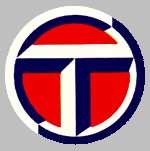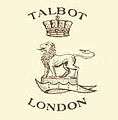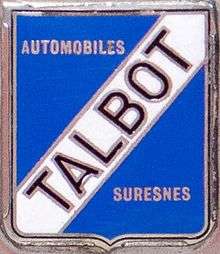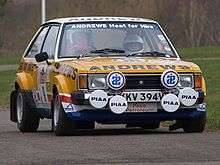Talbot
Talbot or Clément-Talbot Limited was a British automobile manufacturer founded in 1903. Clément-Talbot's products were named just Talbot from shortly after introduction, but the business remained Clément-Talbot Limited until 1938 when it was renamed Sunbeam-Talbot Limited. The founders, Charles Chetwynd-Talbot, 20th Earl of Shrewsbury and Adolphe Clément-Bayard, reduced their financial interests in their Clément-Talbot business during the First World War.
 | |
| Private | |
| Industry | Automotive |
| Fate | Brand retired |
| Predecessor | Clément-Talbot Chrysler Europe |
| Successor | Peugeot |
| Founded |
|
| Defunct | 1994 |
| Headquarters | |
Key people |
|
| Products | Automobile |
| Parent | PSA Peugeot Citroën |
| Website | www |
Soon after the end of the war, Clément-Talbot was brought into a combine named S T D Motors. Shortly afterward, S T D Motors' French products were renamed Talbot instead of Darracq.
In the mid-1930s, with the collapse of S T D Motors, Rootes bought the London Talbot factory and Antonio Lago bought the Paris Talbot factory, Lago producing vehicles under the marques Talbot and Talbot-Lago. Rootes renamed Clément-Talbot Limited Sunbeam-Talbot Limited in 1938, and stopped using the brand name Talbot in the mid-1950s. The Paris factory closed a few years later.
Ownership of the marque came by a series of takeovers to Peugeot S.A., which revived use of the Talbot name from 1978 until 1994.
Talbot London

Clément-Talbot, ultimately Sunbeam-Talbot, Limited was founded in 1903. The first products were cars that were London-assembled mechanical components of French Clément-Bayard cars but the French components were soon replaced by British parts. The brand-name was reduced to Talbot after the first year. |
S T D Motors
In December 1919 A Darracq and Company (1905) Limited of London with its factory in Suresnes, Paris, bought the entire capital of Clément-Talbot and later bought Sunbeam and renamed itself S. T. D. Motors Limited. Those initials referred to Sunbeam, Talbot and Darracq.[4] But in the depth of the Great Depression S T D Motors became unable to pay its debts. Its subsidiaries managed to find buyers and in 1936 S T D Motors ceased to exist.
Talbot London under S T D Motors
_(cropped)_(cropped).jpg)
Clément-Talbot continued to be famous for the design and quality of its products and it remained profitable during the depression. Clément-Talbot was bought by Rootes Group and later renamed Sunbeam-Talbot. Then Sunbeam alone twenty years after that.
Talbot Paris under S T D Motors

In 1920 Suresnes products were branded Talbot-Darracq but the word Darracq was dropped in 1922. If exported to England Paris-made Talbots were rebadged Darracq or Talbot-Darracq
Dragged down by the 1924 borrowing to pay for the Sunbeam racing programme S T D Motors and Automobiles Talbot France suffered a financial collapse in late 1934.
Talbot London under the Rootes brothers
.jpg)
b.jpg)
Following the financial collapse of its parent, S T D Motors, Clément-Talbot remained financially sound with readily marketable products. Clément-Talbot was bought by Rootes Securities and continued to manufacture the same catalogue of vehicles quietly introducing components from Hillman and Humber cars. As the genuine Talbot parts bins ran dry a modified Hillman Aero Minx was introduced to the production line and given the Talbot brand name.
In 1938 this Talbot Ten and its stable mates were badged Sunbeam-Talbot and owner, Clément-Talbot Limited's, name changed to fit.
Talbot Paris under Antonio Lago

Following the financial collapse of S T D Motors and Paris's Automobiles Talbot Antonio Lago, the Suresnes' manager, arranged a management buyout of the French operation.
Antonio Lago involved Talbot in sports car and Grand Prix racing as well as producing high quality luxury cars. In the postwar world of austerity the French government introduced punitive annual taxation on cars with engines larger than 2.6-litres and Talbot sales were severely restricted. Lago continued the Talbot business until 1958 when the factory doors were closed.
The dormant Talbot marque was sold to Simca. Simca was bought by Chrysler Europe in 1970. PSA Peugeot Citroën acquired the still dormant Talbot marque when it bought Chrysler in 1978.
PSA Peugeot Citroën began to use a Talbot badge on former Simca and Chrysler models
Chrysler/Peugeot era (1979-1985)
.jpg)
.jpg)
.jpg)
Chrysler Europe had struggled to make a profit for much of its existence, and had relied on government bailouts to ensure its survival. With mounting pressure on its core North American business, the decision was taken by Chrysler's then CEO Lee Iacocca to offload the ailing European operations. The French Government persuaded both Renault and PSA Peugeot Citroën to bid for the company; as it was keen to keep Simca in domestic ownership.
In August 1978, PSA negotiated a deal with Chrysler to acquire Chrysler Europe for a nominal $1. Although PSA took responsibility for Chrysler Europe's considerable debts and liabilities, the move was a strategic one; acquiring Simca would remove a strong domestic competitor in the French market whilst gaining access to that company's expertise in small front wheel drive cars; whilst at the same the old Rootes operations would give the company a stronger foothold in the United Kingdom – France's biggest export market where both Peugeot and Citroën lagged behind arch rival Renault. PSA formally took control of the old Chrysler Europe on January 1st, 1979.
The Peugeot takeover saw the end of the Rootes' Chrysler Hunter production, but the Chrysler Avenger and Sunbeam (also both Rootes designs), and the Simca 1307 (Chrysler Alpine in UK), and Horizon continued rebadged as Talbots.
All former Chrysler products registered in Britain after 1 August 1979 bore the Talbot badge. Talbot's UK branch manufactured the Alpine, Solara, and Horizon at their aging Ryton plant in Coventry after the British developed cars had all been retired – excepting the UK arm's then largest revenue source, building CKD kits of the Hillman Hunter to be sent to Iran where they were assembled as the Peykan.[5]
The last remaining car produced by the Rootes group, the Chrysler (previously Hillman) Avenger, remained in production as a Talbot until the end of 1981; production also ended, in 1981, of the Avenger-derived Talbot Sunbeam. The entry-level model in the Talbot range from December 1981 onwards would be the Talbot Samba, a three-door hatchback based on the Peugeot 104.
In 1981, Peugeot began producing the Talbot Tagora, a boxy four-door saloon marketed as a Ford Granada or Vauxhall Carlton/Opel Rekord rival. But it was not popular in either Britain or France and production ceased in 1983.
At the end of 1984, the Alpine hatchback and its related Solara saloon were rebadged Minx and Rapier depending upon specification rather than body shape. The new names were inherited from the Rootes Group; Rootes had previously produced the Hillman Minx and Sunbeam Rapier. These cars were produced until 1986. Rootes names still crop up occasionally; in 1982 there was a Talbot Solara "Sceptre" model, the name was inherited from the Humber Sceptre which was produced between 1963 and 1976.
Decline and Demise
In the UK, the Chrysler and Talbot marques had totalled nearly 120,000 sales in 1979, only outsold by Ford and British Leyland, but then went into decline, not helped by the Early 1980s recession or a lack of new models being launched. By 1985 however after years of losses, PSA Peugeot Citroën began to question its three-brand strategy. The Talbot Tagora model failed in the marketplace; the Samba was essentially a decade old design thanks to its Peugeot 104 parentage, whilst the ageing 1510/Alpine/Solara models overlapped with both the Citroën BX and forthcoming Peugeot 405.
At the eleventh hour, the decision was made to release the forthcoming Horizon replacement as the Peugeot 309 instead of Talbot Arizona. It was a controversial decision, as the British arm of the company believed there was greater brand loyalty to Talbot in the UK with its historical connection to the Rootes Group, but the decision to concentrate on the Peugeot brand prevailed, and the 309 became the first of a long line of British-built Peugeot models to be assembled at Ryton. Partly because they were perceived as "British" (despite most of their content actually being imported from PSA's French factories), the 309 and the subsequent 405, 306 and 206 models were hugely successful in the UK market and regularly featured among the country's top ten best selling cars.
Around 1984, PSA had also considered launching a replacement for the Talbot Samba based on the platform of the still under-development Citroën AX, but such was the success of the Peugeot 205 in the supermini sector that PSA felt there was little need for a third supermini in its portfolio. It became clear however, that there was no long term future for the Talbot brand in 1986 when PSA sold the Whitley research and development centre to Jaguar, signalling the end for any more British developed models.
Production of the Horizon continued in Spain and Finland until 1987, marking the end of the Talbot name on passenger cars (the rest of the range had been discontinued in May 1986,[6] although the Talbot Express panel van continued in production until 1994 when the entire Talbot marque was axed.
Talbots in the UK
The Talbot Express van (along with its identical sister vehicle the Fiat Ducato) was a popular base vehicle for motorhomes and campervan conversions, and as a result they are still a relatively common sight on British roads, with many hundreds of examples still in service – compared to an extremely low survival rate of any of the other Chrysler-Peugeot era Talbot passenger car models. According to the website How Many Left? as of June 2016, there were fewer than 40 Alpine/Solara models, 20 Horizons, 10 Sambas and only one Tagora still registered with the British Driver and Vehicle Licensing Agency (DVLA), compared to well over 5000 Talbot Express vans.
Resurrection
In 2008, PSA considered reintroducing Talbot to the market, targeting low-budget buyers, as Renault did with its Dacia Logan. It was suggested that these could be models produced in China such as Talbot versions of the Citroën Elysée and of the Peugeot 206,[7] but did not make a comeback as of 2012 because PSA introduced the second-generation Citroën C-Elysée and the Peugeot 301.
Cars built by Talbot (1967–1994)
- Talbot 1100 1967–1982
- Talbot Alpine/1510 1979–1986
- Talbot Avenger 1970–1981
- Talbot Express Vans 1982–1994
- Talbot Horizon 1979–1987
- Talbot Marathon 1983–1986
- Talbot Matra Murena 1980–1984
- Talbot Minx 1984–1986
- Talbot Rapier 1984–1986
- Talbot Rancho Estate 1977–1984
- Talbot Samba 1981–1986
- Talbot Samba Cabriolet 1983–1986
- Talbot Solara 1980–1986
- Talbot Sunbeam 1977–1981
- Talbot Sunbeam-Lotus GT 1979–1981
- Talbot Tagora 1981–1983
Motorsport
Formula One
Talbot had two brief spells in Formula One. The 4.5-litre, six-cylinder Talbot-Lago T26 was eligible for F1 competition post-war, and many examples, both factory and private, appeared in the first two years of the F1 World Championship, 1950 and 1951. Talbots came fourth and fifth in the inaugural World Championship race, the 1950 British Grand Prix, piloted by Yves Giraud-Cabantous and Louis Rosier respectively. The move to two-litre F2 regulations for 1952 effectively ended Talbot's F1 spell as a manufacturer.
There was a brief participation in Formula One in 1981–1982 by associating with Ligier and using its Matra connection to secure a Matra engine for them, and although the cars were known as Ligier-Matras the team was using the Talbot marque and sponsorship. This lasted two years and was moderately successful, Jacques Laffite coming fourth in the 1981 championship with two wins.
World Rally Championship

The Talbot factory team for the World Rally Championship was founded in 1979, after Peugeot had taken over Chrysler Europe and resurrected the Talbot name. In the team's inaugural season in the series, Tony Pond drove the Talbot Sunbeam Lotus to fourth place at the 1979 Rallye Sanremo. More success followed in the 1980 season; Guy Fréquelin brought Talbot the team's first podium by finishing third at the 1980 Rally Portugal, and then Henri Toivonen won the RAC Rally, becoming the youngest-ever driver to win a world rally. The rally was a big success for Talbot as the team also took the third and fourth places, driven by Fréquelin and Russell Brookes, respectively. This was also the last time that a two-wheel-drive car won the RAC Rally. In the manufacturers' world championship, Talbot placed sixth.
In the 1981 season, Talbot continued with Fréquelin and Toivonen. Although the team's only win came at the Rally Argentina, driven by Fréquelin, consistent podiums and points-scoring finishes saw Talbot take the manufacturers' title. Fréquelin narrowly lost the drivers' title to Ford's Ari Vatanen. The 1982 season saw the series dominated by the four-wheel-drive Audi Quattro, and with Group B regulations coming up, Talbot withdrew from the WRC. However, the Talbot name continued in the championship, as Jean Todt founded the Peugeot Talbot Sport in 1981. This Peugeot factory team debuted in 1984 and won the drivers' and manufacturers' titles in 1985 and 1986.
Complete WRC results
| Year | Car | Driver | 1 | 2 | 3 | 4 | 5 | 6 | 7 | 8 | 9 | 10 | 11 | 12 | WDC | Points | WCC | Points |
|---|---|---|---|---|---|---|---|---|---|---|---|---|---|---|---|---|---|---|
| 1979 | Talbot Sunbeam Lotus | MON | SWE | POR | KEN | GRE | NZL | FIN | CAN | ITA 4 |
FRA | GBR Ret |
CIV | 22nd | 10 | 14th | 12 | |
| MON | SWE | POR | KEN | GRE | NZL | FIN | CAN | ITA Ret |
FRA Ret |
GBR Ret |
CIV | 22nd | 10 | |||||
| 1980 | Talbot Sunbeam Lotus | MON ? |
SWE | POR 3 |
KEN | GRE | ARG | FIN | NZL | ITA 4 |
FRA Ret |
GBR 3 |
CIV | 8th | 34 | 6th | 49 | |
| MON | SWE | POR Ret |
KEN | GRE | ARG | FIN Ret |
NZL | ITA 5 |
FRA | GBR 1 |
CIV | 10th | 28 | |||||
| MON | SWE | POR | KEN | GRE | ARG | FIN | NZL | ITA | FRA | GBR 4 |
CIV | 25th | 10 | |||||
| 1981 | Talbot Sunbeam Lotus | MON 2 |
SWE | POR 6 |
KEN | FRA 2 |
GRE 4 |
ARG 1 |
BRA 2 |
FIN | ITA Ret |
CIV | GBR Ret |
2nd | 89 | 1st | 117 | |
| MON 5 |
SWE | POR 2 |
KEN | FRA Ret |
GRE Ret |
ARG | BRA | FIN Ret |
ITA 2 |
CIV | GBR Ret |
7th | 38 | |||||
| MON | SWE | POR | KEN | FRA | GRE | ARG | BRA | FIN 8 |
ITA | CIV | GBR 3 |
13th | 23 | |||||
| 1982 | Talbot Sunbeam Lotus | MON | SWE | POR | KEN | FRA | GRE | NZL | BRA | FIN | ITA | CIV | GBR 11 |
- | 0 | 10th | 24 | |
| MON | SWE | POR | KEN | FRA | GRE | NZL | BRA | FIN | ITA | CIV | GBR 8 |
4th* | 58* | |||||
Sponsorship
Talbot was the main sponsor of Coventry City football club from 1981 to 1983, and at one stage the club's chairman Jimmy Hill was planning to change the club's name to "Coventry Talbot". However, these plans were vetoed by the Football League and by the summer of 1983 Talbot had ended its association with the club.
References
- "All Car Index". allcarindex.com. Retrieved 3 January 2017.
- "All Car Index". allcarindex.com. Retrieved 3 January 2017.
- "All Car Index". allcarindex.com. Retrieved 3 January 2017.
- S. T. D. Motors, Limited. The Times, Saturday, 18 December 1920; pg. 19; Issue 42597,
- Kent, Gordon (September 1984). Cropley, Steve (ed.). "Oracle". Car. London, UK: FF Publishing: 45.
- Hayward, Matthew (28 July 2011). "The cars : Chrysler Horizon". Retrieved 8 October 2011.
- "Talbot makes a comeback?". Autocar.co.uk. 3 September 2008. Retrieved 10 July 2010.
External links
| Wikimedia Commons has media related to Talbot vehicles. |
- English Heritage: Clement Talbot Car Factory / Ladbroke Grove National Aero-engine Factory, Ladbroke Hall
- The Sunbeam Talbot Darracq Register, additional details on the history of Talbot
- Talbot Owners' Club, a club for Talbot cars manufactured from 1903 up to the last Roesch-designed cars in 1937.
